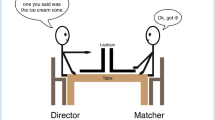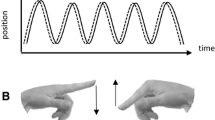Abstract
Autistic adolescents with mild, moderate, and severe degrees of mental retardation, Down's syndrome adolescents, and clinically normal 4-, 5-, and 6-year-old children were compared in their ability to understand a set of simple instrumental gestures. Almost all gestures were perfectly understood, that is, correctly responded to, by normal children from age 5 onwards, and by all the handicapped groups, regardless of diagnosis or degree of retardation. However, the ability to initiate such gestures on verbal request was generally less good, especially in the less able autistic groups. The same subjects were unobtrusively observed in the playground and during mealtime at their schools. Peer interactions were least frequent in the autistic subjects, regardless of degree of mental retardation. However, relative to interaction frequency, the autistic group used nonverbal instrumental gestures as a means of communication to the same extent as the other groups. Unlike Down's syndrome adolescents, or normal preschool children, no autistic adolescent ever used expressive gestures.
Similar content being viewed by others
References
Argyle, M. (1975).Bodily Communication, London: Methuen.
Asperger, H. (1944). Die “autistischen Psychopathen” im Kindesalter.Archiv für Psychiatrie und Nervenkrankheiten, 117, 76–136.
Attwood, A. J. (1984).The gestures of autistic children. Unpublished Ph.D. thesis, University of London, England.
Baron-Cohen, S., Leslie, A. M., & Frith, U. (1985). Does the autistic child have a “theory of mind”?Cognition, 21, 37–46.
Baron-Cohen, S., Leslie, A. M., & Frith, U. (1986). Mechanical, behavioural and intentional understanding of picture stories in autistic children.British Journal of Developmental Psychology, 4, 113–125.
Bartak, L., Rutter, M., & Cox, A. (1975). A comparative study of infantile autism and specific developmental receptive language disorder. I. The children.British Journal of Psychiatry, 126, 127–145.
Barten, S. (1979). The development of gesture. In N. Smith & M. Franklin (Eds.),Symbolic functioning in childhood. New York: Wiley.
Carr, E. G. (1979). Teaching autistic children to use sign language: Some research issues.Journal of Autism and Developmental Disorders, 9, 345–360.
Carr, E. G., & Kologinsky, E. (1983). Acquisition of sign language by autistic children II: Spontaneity and generalization effects.Journal of Applied Behavior Analysis, 16, 297–314.
Clark, P., & Rutter, M. (1981). Autistic children's responses to structure and to interpersonal demands.Journal of Autism and Developmental Disorders, 11, 201–271.
Curcio, F. (1978). Sensorimotor functioning and communication in mute autistic children.Journal of Autism and Childhood Schizophrenia, 8, 281–292.
Curcio, F., & Piserchia, E. (1978). Pantomimic representations in psychotic children.Journal of Autism and Childhood Schizophrenia, 8, 181–189.
Doll, E. A. (1935). The measurement of social competence.Proceedings of the American Association of Mental Deficiency, 40, 103–126.
Doyle, A. B., Connolly, J., & Rivest, L. P. (1980). The effect of playmate familiarity on the social interaction of young children.Child Development, 51, 217–223.
Ekman, P., & Friesen, W. (1972). Hand movements.Journal of Communication, 22, 353–374.
Gibson, D. (1978).Down's syndrome. The psychology of mongolism. Cambridge, England: Cambridge University Press.
Greenwald, C. A., & Leonard, L. B. (1979). Communicative and sensorimotor development of Down's syndrome children.American Journal of Mental Deficiency, 84, 296–303.
Hammes, J. G. W., & Langdell, T. (1981). Precursors of symbol formation and childhood autism.Journal of Autism and Developmental Disorders, 11, 331–345.
Hermelin, B., & O'Connor, N. (1985). Logico-affective states and non-verbal language. In E. Schopler, & G. B. Mesibov (Eds.),Communication problems in autism, New York: Plenum Press.
Hobson, R. P. (1986a). The autistic child's appraisal of expressions of emotion.Journal of Child Psychology and Psychiatry, 27, 321–342.
Hobson, R. P. (1986b). The Autistic child's appraisal of expressions of emotions: a further study.Journal of Child Psychology and Psychiatry, 27, 671–680.
Kanner, L. (1943). Autistic disturbances of affective contact.Nervous Child, 2, 217–250.
Kumin, L., & Lazar, M. (1974). Gestural communication in pre-school children.Perceptual and Motor Skills, 38, 708–710.
Langdell, T. (1981). Face perception.An approach to the study of autism. Unpublished Ph.D. thesis, University of London, England.
Lord, C. (1984). The development of peer relations in children with Autism. In F. J. Morrison, C. Lord, & D. P. Keating (Eds.),Advances in applied developmental psychology, (pp. 165–229). New York: Academic Press.
Lord, C., Merrin, D. J., Vest, L. O., & Kelly, K. M. (1983). Communicative behavior of adults with an autistic four-year-old boy and his nonhandicapped twin brother.Journal of Autism and Developmental Disorders, 13, 1–17.
McHale, S. M. (1983). Social interactions of autistic and nonhandicapped children during free play.American Journal of Orthopsychiatry, 53, 81–91.
McHale, S. M., Simeonsson, R. J., Marcus, L. M., & Olley, J. G. (1980). The social and symbolic quality of autistic children's communication.Journal of Autism and Developmental Disorders, 10, 299–310.
Pototzky, C., & Grigg, A. E. (1942). A revision of the prognosis in mongolism.American Journal of Orthopsychiatry, 12, 503.
Ricks, D. M., & Wing, L. (1976). Language, communication and the use of symbols. In L. Wing (Ed.),Early childhood autism. Oxford, England: Pergamon.
Rutter, M. (1978). Diagnosis and definition. In M. Rutter & E. Schopler (Eds.),Autism: A reappraisal of concepts and treatment. New York: Plenum Press.
Rutter, M. (1983). Cognitive deficits in the pathogenesis of autism.Journal of Child Psychology and Psychiatry, 4, 513–531.
Rutter, M., & Bartak, L. (1973). Special educational treatment of autistic children: A comparative study: II. Follow-up findings and implications for services.Journal of Child Psychiatry, 14, 241–270.
Rutter, M., & Schopler, E. (Eds.) (1978).Autism: A reappraisal of concepts and treatment. New York: Plenum Press.
Volkmar, F. R., & Cohen, D. J. (1982). A hierarchical analysis of patterns of noncompliance in autistic and behavior disturbed children.Journal of Autism and Developmental Disorders, 12, 35–42.
Wing, L. (1981). Asperger's syndrome: A clinical account.Psychological Medicine, 11, 115–129.
Wing, L., & Gould, J. (1979). Severe impairments of social interaction and associated abnormalities in children: Epidemiology and classification.Journal of Autism and Developmental Disorders, 9, 11–29.
Author information
Authors and Affiliations
Additional information
Institute of Education, MRC Developmental Psychology Project
Our particular thanks are due to the Dedisham School for Autistic Children and to many special schools in Croydon and Herefordshire.
Rights and permissions
About this article
Cite this article
Attwood, A., Frith, U. & Hermelin, B. The understanding and use of interpersonal gestures by autistic and Down's syndrome children. J Autism Dev Disord 18, 241–257 (1988). https://doi.org/10.1007/BF02211950
Issue Date:
DOI: https://doi.org/10.1007/BF02211950




